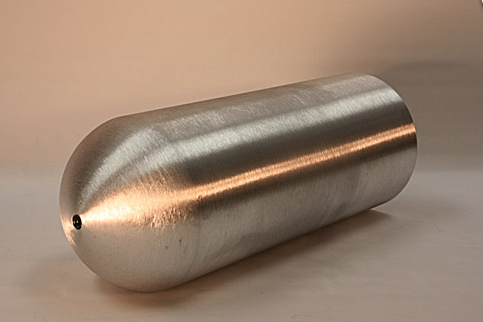 |
|
| 5.60” diameter X 12” to 32” long X 0.250” thickness X 6061-0 aluminum vessel. |
Metal spinning is a unique process that can be used to form complex shapes from aluminum steel, stainless steel, high-strength and high-temperature alloys, and many other metals. Metal spinning is a metalworking process by which a disc or tube of metal is rotated at high speed and formed into an axially symmetric part and is normally performed by hand or with CNC technology. Spinning metal is an inexpensive alternative to the stamping process, with a quicker processing time. Production prototypes can not only be designed on the fly but most changes to a design can be accomplished without added expense to the customer.
Because spun parts have no seams, they can withstand higher internal or external pressures. This is due to grain structure of the metal spun part, which is realigned, improving the metallurgy, as well as improving the tensile strength of the material. This also allows for a lighter gauge material to be used, saving on material cost. Some examples are scuba tanks, CO2 cartridges, and oxyacetylene tanks. Other products that can be produced by metal spinning range from small hardware items made in large quantities, such as metal tumblers and automotive components, to large components for aerospace applications. Metal spinning can be used to cost-effectively produce single or a small number of parts out of expensive materials, such as platinum, or large quantities of components of low-cost materials, such as aluminum. Cost savings are further enhanced from the inherent smooth finish that spinning produces, often eliminating the need for additional machining. Other advantages are very low tooling compared to stamping, as well as very short setup and changeover times. The process is also eco-friendly with less waste being produced.
Metal spinning provides an economical solution for products that require structural integrity. A wide range of shapes can be produced with relatively simple tooling. Here’s a video demonstrating the process at work.
| Description | Carried out by the application of an even, force applied to metal uniformly by rotating the metal at very high rpm’s. Metal is deformed evenly in the metal spinning process without any wrinkling or warping. |
| Equipment Used | Can be performed by hand or by a CNC lathe. |
| Material Used | Virtually any ductile metal may be formed; ranging from aluminum or stainless steel to high-strength, high-temperature alloys. |
| Restrictions | Diameter and depth of formed parts are limited only by the size of the equipment available. |
| Advantages |
|
| Industry for Use | All industry |
| Volume |
Typical production runs of 1,000 pieces or less For prototype and limited production quantities Typical volume range 50,000 units per year |
| Standards Met | Customer specifications |
“Spinning,” Author(s): B.P. Bewlay, General Electric Global Research, D.U. Furrer, Ladish Company
Think metal spinning is the right solution for your business?
